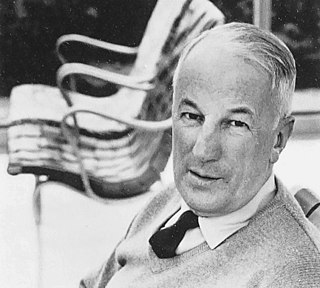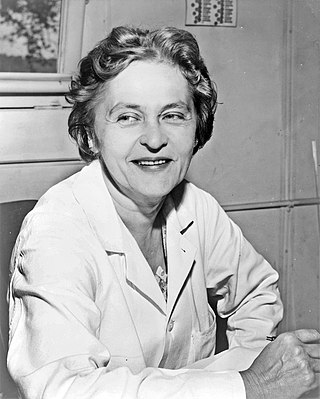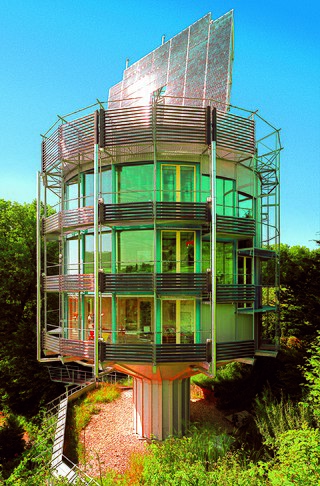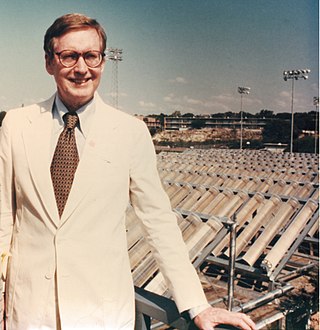Environmental design is the process of addressing surrounding environmental parameters when devising plans, programs, policies, buildings, or products. It seeks to create spaces that will enhance the natural, social, cultural and physical environment of particular areas. Classical prudent design may have always considered environmental factors; however, the environmental movement beginning in the 1940s has made the concept more explicit.

Steve Baer is an American inventor and pioneer of passive solar technology. Baer helped popularize the use of zomes. He took a number of solar power patents, wrote a number of books and publicized his work. Baer served on the board of directors of the U.S. Section of the International Solar Energy Society, and on the board of the New Mexico Solar Energy Association. He was the founder, chairman of the board, president, and director of research at Zomeworks Corporation.

An energy-plus building produces more energy from renewable energy sources, over the course of a year, than it imports from external sources. This is achieved using a combination of microgeneration technology and low-energy building techniques, such as: passive solar building design, insulation and careful site selection and placement. A reduction of modern conveniences can also contribute to energy savings, however many energy-plus houses are almost indistinguishable from a traditional home, preferring instead to use highly energy-efficient appliances, fixtures, etc., throughout the house.

Passive house is a voluntary standard for energy efficiency in a building, which reduces the building's ecological footprint. It results in ultra-low energy buildings that require little energy for space heating or cooling. A similar standard, MINERGIE-P, is used in Switzerland. The standard is not confined to residential properties; several office buildings, schools, kindergartens and a supermarket have also been constructed to the standard. The design is not an attachment or supplement to architectural design, but a design process that integrates with architectural design. Although it is generally applied to new buildings, it has also been used for refurbishments.

Bruno Mathsson was a Swedish furniture designer and architect whose ideas aligned with functionalism, modernism, as well as old Swedish crafts tradition.

Mária Telkes was a Hungarian-American biophysicist and inventor who worked on solar energy technologies.

Eleanor Raymond was an American architect. During a professional career spanning some sixty years of practice, mainly in residential housing, Raymond explored the use of innovative materials and building systems. Much of her work was commissioned by women from her social group in Boston and Cambridge. One client called her “an architect who combines a respect for tradition with a disrespect for its limitations.” The author of a monograph on her life praised her work for its "subtle simplicity without succumbing to architectural exhibitionism".

Herbert and Katherine Jacobs Second House, often called Jacobs II, is a historic house designed by Frank Lloyd Wright and built west of Madison, Wisconsin, United States in 1946–48. The house was the second of two designed by Frank Lloyd Wright for journalist Herbert Jacobs and his wife Katherine. Its design is unusual among Wright's works; he called the style the "Solar Hemicycle" due to its semicircular layout and use of natural materials and orientation to conserve solar energy. The house was added to the National Register of Historic Places in 1974 and declared a National Historic Landmark in 2003.
The passive solar design of buildings includes consideration of their orientation to the sun and their thermal mass, factors which have been incorporated to a greater or lesser extent in vernacular architecture for thousands of years. Ancient Greeks, Romans, and Chinese were the first to refine and develop the basic principles of passive solar design, but European technological advances were largely abandoned after the Fall of Rome. It was not until the 20th century that interest in the principles of passive solar design had a resurgence in Europe and the U.S.A., with architects such as George F. Keck and Frank Lloyd Wright. In the 21st century, worldwide endeavours to reduce power consumption have kept the interest in passive solar technology alive.
Arthur Thomas Brown was an American architect who is remembered as “Tucson’s pioneer of solar design.”
Hoyt Clarke Hottel was a professor in the department of Chemical Engineering at the Massachusetts Institute of Technology (MIT). He was an expert on energy, radiant heat transfer, fire, fuels and combustion.

Sonnenschiff is a large integrated office and retail building in Freiburg im Breisgau, Germany. It was built in 2004 in the city's Vauban quarter as part of the Solar Settlement at Schlierberg. Sonnenschiff was designed by the architect Rolf Disch and generates four times more energy than it uses.

Rolf Disch is a German architect, solar energy pioneer and environmental activist. Born in Freiburg im Breisgau, Germany, Disch has dedicated particular focus to regional renewable and sustainable energy.

The Heliotrope is a design of environmentally friendly housing by German architect Rolf Disch. Three such buildings exist in Germany; the first experimental version was built in 1994 as the architect's home in Freiburg im Breisgau, while the other two were used as exhibition buildings for the Hansgrohe company in Offenburg and a dentist's lab in Hilpoltstein in Bavaria.

The Solar Settlement at Schlierberg is a 59-home PlusEnergy housing community in Freiburg, Germany. Solar architect Rolf Disch wanted to apply his PlusEnergy concept, created originally with his Heliotrope home, to mass residential production. The residential complex won such awards as House of the Year (2002), Residential PV solar integration award (2002), and "Germany's most beautiful housing community" (2006). It is one of the first housing communities in the world in which all the homes produce a positive energy balance and which is emissions-free and CO2 neutral.
George Oscar Löf was an American engineer and inventor who was best known for his contributions to solar energy research. "Nobody played a more enduring role in the 20th century solar house movement than George Löf."
German developments that employ green building techniques include:

Solar air heating is a solar thermal technology in which the energy from the sun, insolation, is captured by an absorbing medium and used to heat air. Solar air heating is a renewable energy heating technology used to heat or condition air for buildings or process heat applications. It is typically the most cost-effective out of all the solar technologies, especially in commercial and industrial applications, and it addresses the largest usage of building energy in heating climates, which is space heating and industrial process heating.

Leonard "Lynn" L. Northrup Jr. was an American engineer who was a pioneer of the commercialization of solar thermal energy. Influenced by the work of John Yellott, Maria Telkes, and Harry Tabor, Northrup's company designed, patented, developed and manufactured some of the first commercial solar water heaters, solar concentrators, solar-powered air conditioning systems, solar power towers and photovoltaic thermal hybrid systems in the United States. The company he founded became part of ARCO Solar, which in turn became BP Solar, which became the largest solar energy company in the world. Northrup was a prolific inventor with 14 US patents.

Ralph Lewis Knowles is an American professor emeritus of architecture and a leading theorist of solar access design. He created the concept of the "solar envelope" and championed solar access planning. The solar envelope has influenced many city design and planning documents. He is a fellow of the American Solar Energy Society and an ACSA Distinguished Professor. He received the prestigious AIA Medal for research in 1974.

















